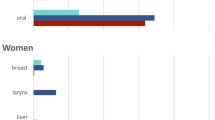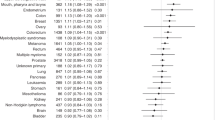Abstract
Objectives
The purpose of this study was to estimate the proportion and number of cancer cases diagnosed in Ontario in 2012 that are attributable to alcohol consumption and to compare the impact of drinking within two sets of guidelines on alcohol-attributable cancer incidence.
Methods
We estimated the proportion of cancers in Ontario attributable to alcohol consumption by calculating population-attributable fractions (PAFs) for six cancer types using drinking prevalence from the 2000/2001 Canadian Community Health Survey and relative risks from a meta-analysis. Each PAF was multiplied by the number of incident cancers in 2012, allowing for a 12-year latency period, to calculate the number of alcohol-attributable cases. We also estimated the number of alcohol-attributable cases under two scenarios: (1) assuming consumption had not exceeded the levels recommended by the Low-Risk Alcohol Drinking Guidelines (LRADG) and (2) assuming consumption had not exceeded the recommended levels by the World Cancer Research Fund/American Institute for Cancer Research (WCRF/AICR) guidelines.
Results
One thousand two hundred ninety-five (95% confidence interval 1093–1499) new cases of cancer diagnosed in Ontario during 2012 are estimated to be attributed to alcohol consumption, representing approximately 1.7% (1.4–1.9%) of all new cancer cases. If no Ontario adults had exceeded the LRADG, an estimated 321 fewer cancer cases could have been diagnosed in 2012, whereas an estimated 482 fewer cancer cases could have been diagnosed if no Ontario adults had exceeded the stricter WCRF/AICR guidelines.
Conclusion
Strategies to limit alcohol consumption to the levels recommended by drinking guidelines could potentially reduce the cancer burden in Ontario.
Résumé
Objectifs
Estimer la proportion et le nombre de cas de cancer diagnostiqués en Ontario en 2012 qui étaient attribuables à la consommation d’alcool et comparer les effets de cette consommation selon deux ensembles de directives sur l’incidence des cancers attribuables à la consommation d’alcool.
Méthode
Nous avons estimé la proportion des cancers attribuables à consommation d’alcool en Ontario en calculant les fractions attribuables dans la population (FAP) pour six types de cancer à l’aide de la prévalence de la consommation selon l’Enquête sur la santé dans les collectivités canadiennes de 2000–2001 et les risques relatifs d’une méta-analyse. Chaque FAP a été multipliée par le nombre de nouveaux cas de cancer en 2012, en tenant compte d’une période de latence de 12 ans, pour calculer le nombre de cas attribuables à la consommation d’alcool. Nous avons aussi estimé le nombre de cas attribuables à la consommation d’alcool selon deux scénarios : 1) en supposant une consommation ne dépassant pas les niveaux recommandés dans les Directives de consommation d’alcool à faible risque (DCAFR); et 2) en supposant une consommation ne dépassant pas les niveaux recommandés dans les directives conjointes du World Cancer Research Fund et de l’American Institute for Cancer Research (WCRF/AICR).
Résultats
Il est estimé que 1295 (intervalle de confiance de 95%: 1093–1499) nouveaux cas de cancer diagnostiqués en Ontario en 2012 étaient attribuables à la consommation d’alcool, soit environ 1,7% (1,4%–1,9%) des nouveaux cas de cancer. Si aucun adulte ontarien n’avait dépassé les DCAFR, il est. estimé que 321 cas de cancer en moins auraient été diagnostiqués en 2012, tandis que 482 cas de cancer en moins auraient été diagnostiqués si aucun adulte ontarien n’avait dépassé les directives plus strictes du WCRF et de l’AICR.
Conclusion
Des stratégies visant à limiter la consommation d’alcool aux niveaux recommandés dans les directives de consommation pourraient potentiellement réduire le fardeau du cancer en Ontario.

Similar content being viewed by others
Change history
18 May 2018
Due to a production error, the PDF of this article published without the French translation of its Abstract (Résumé) and Keywords (Mots-clés), now displayed here.
References
Bagnardi, V., Rota, M., Botteri, E., Tramacere, I., Islami, F., Fedirko, V., et al. (2015). Alcohol consumption and site-specific cancer risk: a comprehensive dose-response meta-analysis. British Journal of Cancer, 112(3), 580–593.
Beland, Y. (2002). Canadian community health survey—methodological overview. Health Reports, 13(3), 9–14.
Boffetta, P., & Hashibe, M. (2006). Alcohol and cancer. The Lancet Oncology, 7(2), 149–156.
Canadian Cancer Society. Alcohol [Internet]. 2016 [cited 2016 Dec 20]. Available from: http://www.cancer.ca/en/prevention-and-screening/live-well/alcohol/?region=on.
Canadian Centre on Substance Abuse. Canada’s low-risk alcohol drinking guidelines [Internet]. 2011 [cited 2016 Dec 14]. Available from: http://www.ccsa.ca/Eng/topics/alcohol/drinking-guidelines/Pages/default.aspx.
Cancer Care Ontario. (2014). Cancer risk factors in Ontario: alcohol. Toronto: Queen's Printer for Ontario.
Cancer Care Ontario. Technical Appendix to Cancer Risk Factors in Ontario: Alcohol [Internet]. 2014 [cited 2016 Dec 20]. Available from: https://www.cancercare.on.ca/common/pages/UserFile.aspx?fileId=303134.
Grundy, A., Poirier, A. E., Khandwala, F., McFadden, A., Friedenreich, C. M., & Brenner, D. R. (2016). Cancer incidence attributable to alcohol consumption in Alberta in 2012. CMAJ Open, 4(3), E507–EE14.
Hashibe, M., Brennan, P., Chuang, S. C., Boccia, S., Castellsague, X., Chen, C., et al. (2009). Interaction between tobacco and alcohol use and the risk of head and neck cancer: pooled analysis in the International Head and Neck Cancer Epidemiology Consortium. Cancer epidemiology, Biomarkers & Prevention: A Publication of the American Association for Cancer Research, cosponsored by the American Society of Preventive Oncology, 18(2), 541–550.
International Agency for Research on Cancer. (2012). IARC monographs on the evaluation of carcinogenic risks to humans. Volume 100E. A review of human carcinogens. Part E: Personal habits and indoor combustions. Lyon: International Agency for Research on Cancer.
Kalinowski, A., & Humphreys, K. (2016). Governmental standard drink definitions and low-risk alcohol consumption guidelines in 37 countries. Addiction (Abingdon, England), 111(7), 1293–1298.
Pandeya, N., Wilson, L. F., Webb, P. M., Neale, R. E., Bain, C. J., & Whiteman, D. C. (2015). Cancers in Australia in 2010 attributable to the consumption of alcohol. Australian and New Zealand Journal of Public Health, 39(5), 408–413.
Parkin, D. M. (2011). 3. Cancers attributable to consumption of alcohol in the UK in 2010. British Journal of Cancer, 105(Suppl 2), S14–S18.
Praud, D., Rota, M., Rehm, J., Shield, K., Zatonski, W., Hashibe, M., et al. (2016). Cancer incidence and mortality attributable to alcohol consumption. International Journal of Cancer, 138(6), 1380–1387.
Rehm, J., Baliunas, D., Borges, G. L., Graham, K., Irving, H., Kehoe, T., et al. (2010). The relation between different dimensions of alcohol consumption and burden of disease: an overview. Addiction (Abingdon, England), 105(5), 817–843.
Schutze, M., Boeing, H., Pischon, T., Rehm, J., Kehoe, T., Gmel, G., et al. (2011). Alcohol attributable burden of incidence of cancer in eight European countries based on results from prospective cohort study. BMJ (Clinical Research Ed), 342, d1584.
Shield, K. D., & Rehm, J. (2012). Difficulties with telephone-based surveys on alcohol consumption in high-income countries: the Canadian example. International Journal of Methods in Psychiatric Research, 21(1), 17–28.
Shield, K. D., Parry, C., & Rehm, J. (2013). Chronic diseases and conditions related to alcohol use. Alcohol Research: Current Reviews, 35(2), 155–173.
Stockwell, T., Zhao, J., & Macdonald, S. (2014). Who under-reports their alcohol consumption in telephone surveys and by how much? An application of the ‘yesterday method’ in a national Canadian substance use survey. Addiction (Abingdon, England), 109(10), 1657–1666.
Stockwell, T., Zhao, J., Greenfield, T., Li, J., Livingston, M., & Meng, Y. (2016). Estimating under- and over-reporting of drinking in national surveys of alcohol consumption: identification of consistent biases across four English-speaking countries. Addiction (Abingdon, England), 111(7), 1203–1213.
World Cancer Research Fund/American Institute for Cancer Research. (2007). Food, nutrition, physical activity, and the prevention of cancer. Washington, DC: AICR.
Acknowledgements
The authors thank Sue Greco for assistance in using @RISK.
Author information
Authors and Affiliations
Corresponding author
Ethics declarations
Conflict of interest
The authors declare that they have no conflict of interest.
Rights and permissions
About this article
Cite this article
Young, S.W., Candido, E., Klein-Geltink, J. et al. Preventing alcohol-related cancer: what if everyone drank within the guidelines?. Can J Public Health 109, 70–78 (2018). https://doi.org/10.17269/s41997-018-0033-x
Published:
Issue Date:
DOI: https://doi.org/10.17269/s41997-018-0033-x




